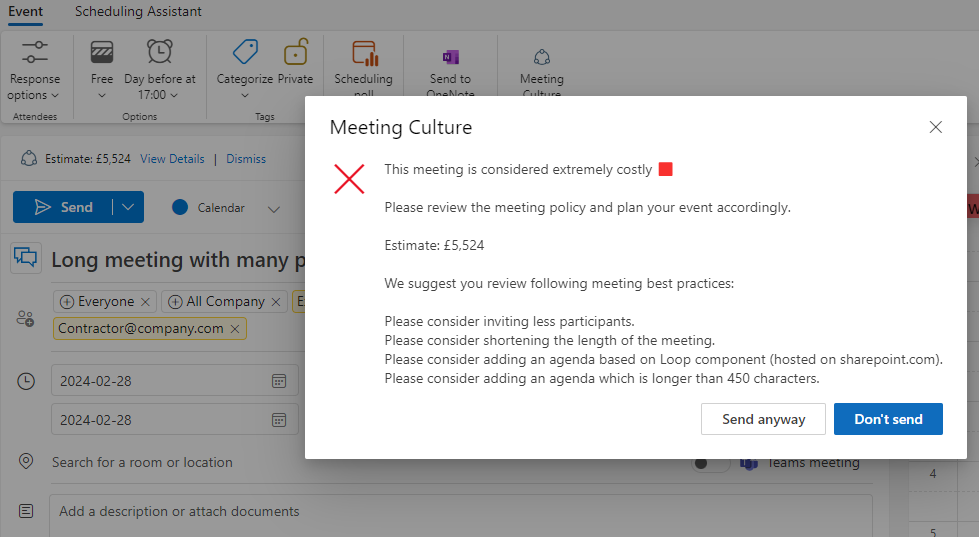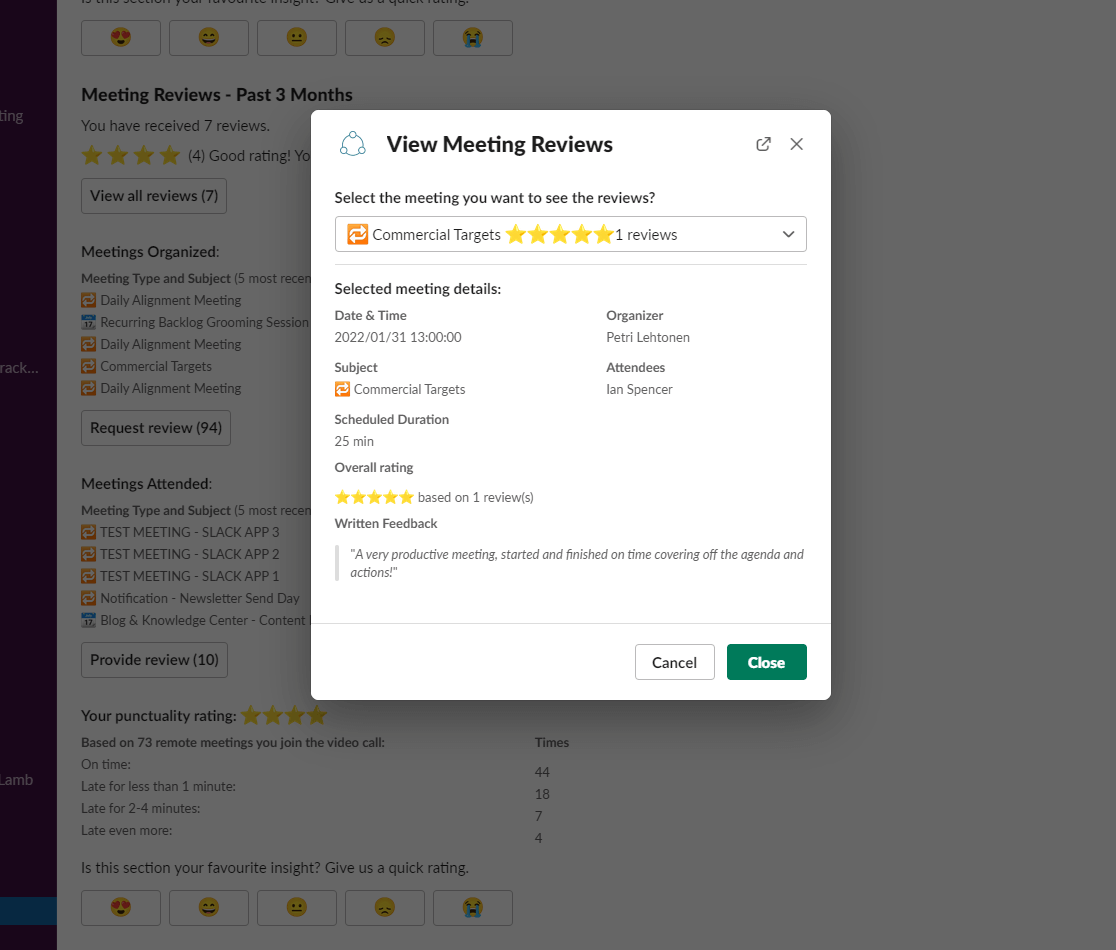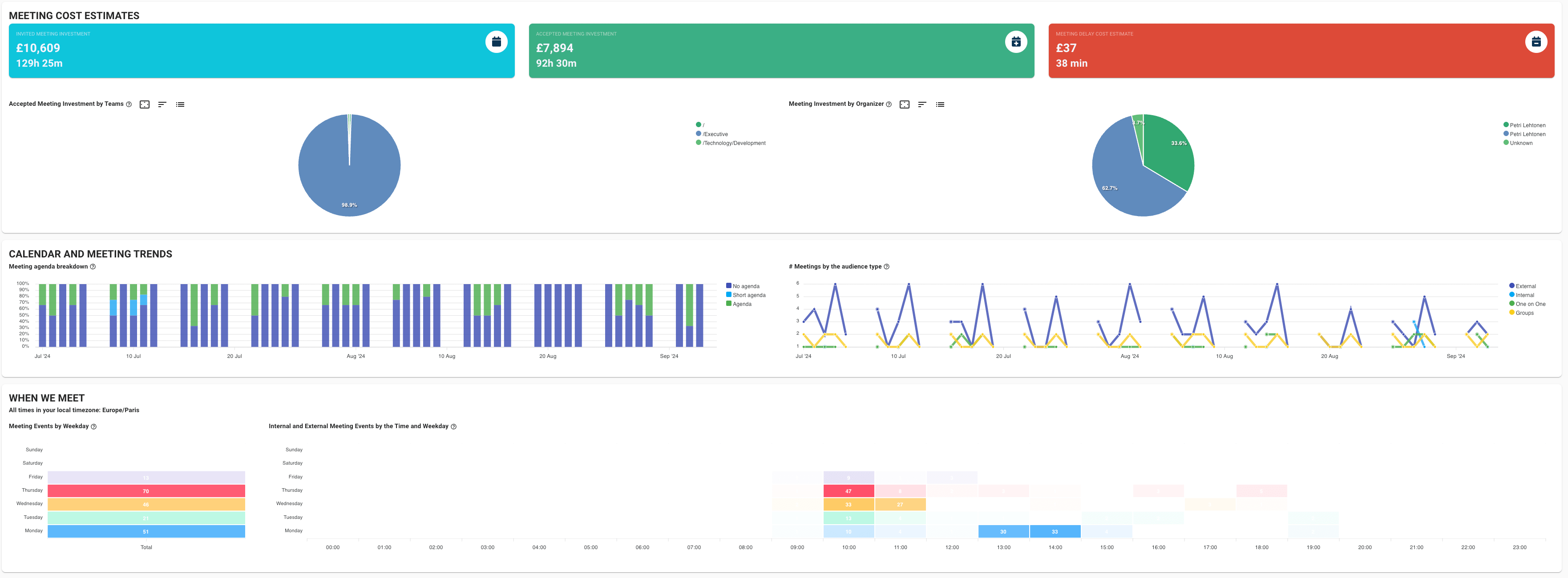Key Metrics For Assessing Meeting Effectiveness
Optimize meeting effectiveness with data-driven metrics on preparation, cost, participation, timing, and accountability to enhance productivity and...
Discover meeting strategies from top executives like Elon Musk, Steve Jobs, and Satya Nadella to boost productivity, decision-making, and team alignment in your organization.
Effective meeting strategies are key for driving productivity, aligning teams, and making informed decisions within any organization. Meetings can either be a powerful tool for collaboration or a drain on time and resources, depending on how well they are structured and executed. Learning from the meeting strategies of successful top executives offers valuable insights that can impact a company's meeting culture.
Meeting culture is about more than just gathering people in a room or on a video call, it's about maximizing the value of those interactions. When executed effectively, meetings lead to clearer communication, quicker decision-making, and stronger collaboration across teams. Adopting the right strategies, as demonstrated by some of the most successful leaders, can significantly improve how organizations conduct their meetings, leading to greater overall efficiency.
Elon Musk, known for his leadership at Tesla and SpaceX, emphasizes the importance of being prepared for meetings. He ensures that everyone comes to the meeting with a clear understanding of the material and ready to answer any follow-up questions. This strategy eliminates uncertainty and helps cut down on time wasted in meetings, making the session more efficient and to the point. A prepared team leads to quicker decision-making, higher standards, and a more productive atmosphere.
In fact, research suggests that the average employee spends 31 hours per month in unproductive meetings. This waste of time can often be attributed to poor preparation. When attendees come into a meeting unprepared, discussions tend to drift off-topic, decisions are delayed, and the time spent often exceeds what was originally planned. Musk’s approach of ensuring thorough preparation means that every minute of a meeting is utilized effectively, keeping discussions focused on the agenda and facilitating quicker outcomes.
To implement this strategy within your organization, it’s essential to build a culture where preparation is valued. Begin by setting clear objectives for every meeting and ensure that all participants are provided with necessary documents, data, or resources well in advance.

By making preparation a non-negotiable aspect of the meeting culture, employees are more likely to walk into meetings knowing the objectives and having well-formed ideas ready for discussion. This not only boosts productivity but also ensures that meetings stay on track and remain goal-focused.
Preparing for meetings is crucial for maximizing efficiency and ensuring that every moment spent in a meeting drives progress. When participants come prepared, they can dive straight into meaningful discussions, reducing time wasted on explanations or clarifications. Thorough preparation leads to well-informed conversations, faster problem-solving, and better decision-making. It also sets a standard of accountability, where each participant is expected to contribute meaningfully, fostering a culture of high productivity and excellence.
Steve Jobs, co-founder of Apple, was known for his philosophy of keeping meetings small and exclusive to those who were absolutely essential. Jobs believed that inviting only the most relevant participants ensured that meetings remained productive, with each attendee contributing significantly to the discussion. A smaller group not only allows for more direct communication but also keeps the focus sharp, minimizing the risk of off-topic conversations.
Research supports this idea, with studies showing that smaller meetings are 25% more productive than larger ones due to fewer distractions and more focused discussions. When too many people are involved, the meeting can become unmanageable, and decision-making processes can slow down. By limiting the number of attendees, Jobs ensured that meetings were concise, collaborative, and effective.

To implement this strategy, consider these steps:
By keeping the attendee list tight, meetings become more focused, and participants are more engaged, contributing meaningfully to the discussion. The smaller the group, the easier it is to stay on track and make decisions quickly.
Keeping meetings small is essential for maintaining focus and driving efficiency. When only the most relevant participants are invited, discussions become more concentrated, with everyone playing a critical role. Smaller meetings allow for more active engagement from all participants and prevent unnecessary tangents that can arise in larger groups. This leads to quicker decision-making and more impactful outcomes. By limiting attendees to those who are directly involved, organizations can reduce meeting time and enhance the quality of collaboration.
Larry Page, co-founder of Google, emphasized the importance of making decisions without always waiting for formal meetings. By enabling faster decision-making, teams can move more quickly, adapt to changes in real-time, and avoid bottlenecks that slow down projects. This approach fosters agility and encourages a proactive work environment where problems are addressed swiftly, keeping momentum alive.
In many organizations, decisions are often delayed until the next meeting, leading to lost time and stagnation. Page’s philosophy encourages a shift in mindset, where team members are empowered to make decisions when the information is available rather than waiting for a scheduled gathering. This ensures that progress continues and delays are minimized, especially in fast-paced environments.

To implement this strategy, consider these steps:
Immediate decision-making helps organizations stay agile and responsive in fast-moving environments. When decisions are made without waiting for formal meetings, teams can continue to make progress without unnecessary delays. This approach reduces bottlenecks and accelerates workflows, allowing organizations to adapt quickly to new challenges or opportunities. Immediate decision-making fosters a culture of action and decisiveness, ensuring that problems are addressed promptly, keeping projects on track and maintaining momentum across the organization.
Satya Nadella, CEO of Microsoft, advocates for long, detailed leadership meetings to ensure alignment across different units of an organization. These extended meetings provide the opportunity to dive deep into strategic planning, performance reviews, and cross-functional coordination. By bringing leadership together regularly, organizations can ensure that goals are being met, challenges are addressed, and every team remains focused on the company’s overall mission.
The value of these long-form leadership meetings lies in their ability to offer a comprehensive review of progress and foster communication among departments that might otherwise operate in silos. Leaders can take a step back from the day-to-day tasks to focus on broader organizational strategies, while also addressing any misalignments or roadblocks.
To implement Satya Nadella’s approach to leadership meetings, consider these steps:
Extended leadership meetings offer an environment where senior managers can discuss important issues in depth, plan for the future, and ensure the alignment of their teams. Regular leadership touchpoints ensure that the entire organization is moving in the same direction, with consistent goals and clear communication. It’s not just about checking in—these meetings are essential for organizational cohesion and long-term planning.
Leaders can address performance gaps, celebrate successes, and make decisions that resonate across departments, creating a more unified and productive organization.
Ben Horowitz, co-founder of Andreessen Horowitz, emphasizes the power of structured one-on-one meetings as a way to foster strong personal connections between managers and employees. These meetings offer an opportunity for direct reports to share insights, raise concerns, and discuss career development in a setting that encourages deep listening and thoughtful response. The key to making one-on-one meetings effective lies in giving employees the lead, allowing them to set the agenda and ensuring the manager is focused primarily on listening.
One-on-one meetings create a safe space for honest conversations and provide valuable feedback for both the employee and the manager. They are essential for understanding the individual needs of employees, improving job satisfaction, and driving professional growth.

To implement Ben Horowitz’s strategy, here are some practical steps:
One-on-one meetings are crucial for maintaining a strong connection between employees and their managers. They offer a unique opportunity for personalized feedback, professional development discussions, and addressing concerns that might not come up in larger team settings. By providing a dedicated time for open, two-way communication, these meetings can help prevent misunderstandings and improve job satisfaction.
These meetings also help managers stay connected with their team’s challenges and successes on an individual level, which can lead to more tailored management approaches and better overall team performance. Regular one-on-ones ensure that employees feel supported and empowered to grow within the organization.
Marissa Mayer, former CEO of Yahoo, is known for her methodical approach to vetting ideas during meetings. By rigorously challenging concepts and proposals, she ensures that decisions are based on solid research and thorough analysis. Mayer's approach highlights the importance of creating a culture where ideas are tested, scrutinized, and improved before being implemented. This approach can help avoid costly mistakes and lead to better, more innovative solutions.
Thorough vetting ensures that decisions made during meetings are well-informed and backed by comprehensive data. This leads to higher-quality outcomes and instills confidence in the direction chosen by the team.
To adopt Mayer’s strategy of aggressive vetting, here are some practical methods:
Thoroughly vetting ideas helps prevent hasty decision-making and encourages team members to be more thoughtful in their proposals. By rigorously testing ideas during meetings, organizations can avoid unnecessary risks and improve the overall quality of decision-making. It also ensures that when decisions are made, they are based on the best possible information, which leads to more effective and strategic outcomes.
This approach can also boost creativity and innovation by encouraging participants to push the boundaries of their ideas. When people know their ideas will be scrutinized, they tend to come more prepared and develop stronger, more well-thought-out concepts. The result is a culture of excellence and continuous improvement.
Alfred Sloan, former CEO of General Motors, was a firm believer in the importance of follow-up memos after meetings. These memos serve to summarize key discussions, set clear deadlines, and assign accountability for tasks or decisions made during the meeting. Follow-up memos ensure that the momentum from a meeting continues beyond the discussion and that everyone is on the same page regarding their responsibilities. This post-meeting practice minimizes confusion and provides a reference point for all involved, making it much easier to track progress and ensure accountability.

To implement Sloan’s strategy of sending follow-up memos, consider the following steps:
Follow-up memos are crucial for ensuring that meetings translate into action. They serve as a formal record of what was discussed, decided, and delegated, reducing the likelihood of misunderstandings or forgotten tasks. With clear deadlines and assigned accountability, follow-up memos provide structure and clarity, keeping teams focused on their responsibilities and preventing tasks from falling through the cracks. This practice also fosters a culture of accountability and follow-through, ensuring that meetings result in tangible progress rather than being purely conversational.
Sending follow-up memos not only improves communication but also helps in tracking long-term progress. They act as a tool for accountability and ensure that discussions lead to actionable results.
Sheryl Sandberg, COO of Meta (formerly Facebook), is a strong advocate for using strict agendas to keep meetings focused and productive. By adhering closely to a predefined agenda, meetings are less likely to drift off-topic or run over time, ensuring that discussions remain purposeful and efficient. Sandberg’s approach also emphasizes action items, ensuring that every meeting results in clear next steps and tangible outcomes.
Without a strict agenda, meetings can become unproductive, with discussions wandering off track or key issues being overlooked. Sandberg’s strategy prevents this by enforcing discipline in the structure and flow of the meeting, making sure that each item is addressed within a set timeframe.

To implement Sandberg’s strategy of strict agenda management, follow these steps:
Strict adherence to an agenda keeps meetings efficient, reducing the risk of wasted time. Meetings that follow an agenda are more likely to cover important points, avoid off-topic discussions, and conclude on time. Additionally, by focusing on action items, the meeting ensures that discussions translate into concrete outcomes. This approach prevents “meeting fatigue,” where participants feel that meetings are too frequent or lack direction, ultimately improving the overall productivity of the team.
A well-structured agenda with clearly defined goals also allows participants to prepare in advance, ensuring that everyone comes ready to engage meaningfully with the topics at hand. Strict agendas create an environment where meetings are seen as a productive use of time rather than a distraction from core work.
Flowtrace is designed to enhance and optimize meeting efficiency by providing detailed insights into meeting behaviors and trends. With its analytics-driven dashboard, Flowtrace tracks important metrics such as meeting frequency, time spent in meetings, adherence to agendas, and meeting costs. This data helps organizations identify inefficiencies, such as meetings without clear agendas, frequent delays, or participant overload, and implement strategies to improve productivity.

Flowtrace supports the meeting strategies of top executives, for example, Flowtrace helps organizations ensure that meetings are well-prepared and agenda-driven (Sheryl Sandberg’s strict agendas), minimize unnecessary participants (Steve Jobs’ lean meetings), and track time spent in leadership or one-on-one meetings (Ben Horowitz’s structured one-on-ones). By using Flowtrace, companies can support a culture of purposeful, data-driven meetings that lead to better outcomes and increased efficiency.
The meeting strategies from top executives like Elon Musk, Steve Jobs, and Sheryl Sandberg provide valuable insights into running more effective, focused, and productive meetings. Adopting these practices in modern organizations can lead to improved decision-making and greater efficiency. Leveraging tools like Flowtrace can help integrate these strategies into your company’s meeting culture by offering data-driven insights, optimizing agendas, and reducing meeting overload, ultimately driving success and boosting overall productivity.
Source for meeting strategies: WildCapital.co
Optimize meeting effectiveness with data-driven metrics on preparation, cost, participation, timing, and accountability to enhance productivity and...
Optimize meetings to save costs and boost productivity with these 8 strategies, including agendas, right participants, punctuality, and analytics.
Discover the hidden costs of meetings and learn strategies to manage them effectively for increased productivity and reduced expenses.